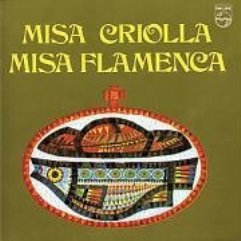Ariel Ramirez – Misa Criolla; José Torregrosa - Misa Flamenca (1989)
Ariel Ramirez – Misa Criolla; José Torregrosa - Misa Flamenca (1989)

Misa Criolla: 1. Kyrie (Vidala-Baguala) 2. Gloria (Carnavalito-Yaravi) 3. Credo (Chacarera Trunca) 4. Sanctus (Carnaval Cochabambino) 5. Agnus Dei (Estilo Pampeano) Los Fronterizos: Gerardo López, Eduardo Madeo, Juan Carlos Moreno, Yayo Quesada Misa Flamenca: 1. Kyrie 2. Gloria 3. Credo 4. Sanctus 5. Agnus Dei Pepe "El Culata", Victor Monje "Serranito", Ramón de Algeciras, Los Serranos, Raphael Romero, Pericon "Chocolate" De Cadiz, Pepe "El Culata", Ramón de Algeciras, Choir Maitea, Coro Easo José Torregrosa - conductor
This album, quite famous at the time of its original release around 1968, is an attempt to produce two masses using authentic folk music and performers.
The Misa Flamenca, like most such fusion attempts, it is not entirely successful, and (despite moments of great beauty) "interesting" is perhaps the best word for the result: this despite the use of top-notch artists such as (in the Misa Flamenca) singers Rafael Romero, El Chocolate, El Culata and Los Serranos, plus guitarists Serranito and Ramón de Algeciras. The sudden lurches from (for example) a genuine Caña to a full church choir are unnerving, to say the least.
In my opinion, the Misa Criolla, which uses Latin American music, is the more felicitous.
The sleeve notes are unusual in being in French alone, and containing no information whatever about the flamenco artists. ---Paul Magnussen, amazon.com
Ariel Ramírez composed the Misa Criolla in 1964 as one of the first masses in the national idiom. Ramírez not only used the language of his country but also the musical rhythms of Argentina, partly played by local instruments.It is a Creole Mass indeed. Creole means: native which is not the same as indigenous. The Argentine Creoles are descendents of many peoples, such as Europeans and Indians. New immigrants are called gringos. The Argentine rhythms and instruments also descend from many places.
The first recording of the Misa Criolla took place in 1964, sung by the choir of the Basílica del Socorro and the folkloric male quartet 'Los Fronterizos', who sang the soloist parts either one by one or together. The first live performance took place in Colón Theatre in Buenos Aires in 1965 (you can read a critic about this concert on the Ariel Ramirez website), the first European performances were in March 1967 in Germany. The score was edited in 1965 in Buenos Aires, together with the score of the Christmas cantata Navidad Nuestra. The Misa Criolla became extremely popular. It was sung all over the world and its recordings were sold in huge amounts. Almost 25 years after its birth, millions of CD's of the piece were sold when the famous classical tenor José Carreras recorded it (1988). At the end of 1998, Ramírez performed the mass in Buenos Aires with the three main folkloric singers that sung the mass in its 35 years of existence: Gerardo López ( Los Fronterizos, he died in 2004), Zamba Quipildor and Javier Rodríguez. The mass was more recently recorded by Mercedes Sosa (1999) and by Javier Rodríguez (2002). ---home.planet.nl
Al compositor José Torregrosa, en colaboración con Ricardo Fernández de Latorre, se debe la creación de una de las primeras misas flamencas grabadas y que, como otras misas populares, es fruto directo del espíritu emanado del Concilio Vaticano II. La obra del alicantino, una suerte de hibridación entre el mundo clásico y el flamenco, tuvo una amplia repercusión al formar parte del elenco de misas populares grabadas por la discográfica Philips. ---revistas.um.es
download: uploaded yandex 4shared mediafire solidfiles mega filecloudio nornar ziddu
Zmieniony (Wtorek, 01 Kwiecień 2014 13:03)
